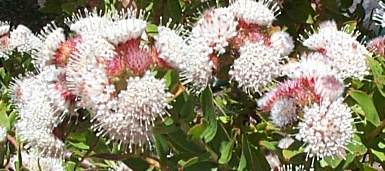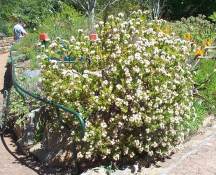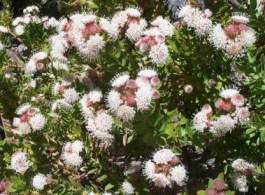Leucospermum bolusii
Leucospermum bolusii Gand.
Family: Proteaceae
Common names: Gordon's Bay pincushion (Eng.); witluisiesbos (Afr.)
Introduction
The Gordon's Bay pincushion is quite unusual for a pincushion in that its flowers are a creamy white colour where they are normally a striking orange or yellow, and fragrant where they normally are not. It is also an easy one to grow, and it is a good cutflower.

Description
Description
Leucospermum bolusii grows into a rounded shrub, about 1.5 m tall. The leaves are hairy when young, and have one apical tooth. The flowerheads are flat and rounded, about 20 mm in diameter, each one made up of 50 - 100 small tubular flowers. The buds are encased by pinkish red bracts, and the flowers are creamy white, with a strong, sweet fragrance that is very noticeable on windless evenings. Flowering time is spring to midsummer (September to December), peaking in late October to early November. The nut-like seeds drop out of the flowers about two months after flowering.

Conservation Status
Status
Leucospermum bolusii is a rare endemic with a relatively small distribution range. Although dense stands of it occur is is assessed as Near Threatened as it is at risk from too frequent fire, invasive alien plants and urban development.
Distribution and habitat
Distribution description
This pincushion is found in a small area on rocky, west-facing, sandstone slopes of the mountains above Clarence Drive, between Gordon's Bay and Kogel Bay, overlooking False Bay.
Derivation of name and historical aspects
History
The genus Leucospermum is named from the Greek leukos meaning white, and sperma seed, referring to the white or light-coloured seeds of many species. This species is named after Harry Bolus (1834-1911), a South African botanist and founder of the Bolus Herbarium in Cape Town. It gets its common name from its restricted habitat above Gordon's Bay, and its Afrikaans name refers to its white flowers and the tick-like appearance of the seeds (wit meaning white, luisies are little ticks and a bos is a bush). Many other pincushions are also called luisiesbos.
The genus Leucospermum is a member of the protea family. It consists of 48 species that occur in southern Africa as far north as Zimbabwe, with the majority occurring in the winter rainfall regions of Western Cape.
Ecology
Ecology
The flowers are pollinated by bees, wasps, flies, butterflies and moths. The seeds are dispersed by ants that are attracted to the fleshy skin that covers the seed, called an elaisome. The ants carry the seeds to their underground nests where they consume the elaisome, but the seed remains safe until conditions are right for them to germinate. Leucospermum bolusii is killed by fire, i.e. it is not a resprouter, but its seeds survive.

Growing Leucospermum bolusii
Grow
Leucospermum bolusii is a good garden subject and an excellent cutflower. It does best in well-drained, acid sandstone soils in a sunny position. Like most members of the protea family, it is intolerant of rich soils and strong doses of chemical fertilizers with high nitrogen (N) and phosphorous (P) content. In heavy clay soils or waterlogged conditions they are more susceptible to infection with the root fungus Phytophthora.
Feed with well-rotted compost, dug into the planting hole and thereafter laid down over the surface of the soil as a thick mulch at least once every year, or in both autumn and again in spring.
Seed germinates easily in late summer - autumn - early winter (March - May). They don't need to be treated with smoke primer to initiate germination, but do respond to the typical autumn hot day and cold night temperature fluctuations. They are usually ready for planting into bags/containers after three to four months.
This pincushion can also be propagated by cuttings. Semi-hardwood tip cuttings or heel cuttings should be taken in late summer - autumn and rooted with bottom heat in a mist unit. A rooting hormone is required for optimal rooting.
References
- Goldblatt, P. & Manning, J. 2000. Cape plants. A conspectus of the Cape flora of South Africa. Strelitzia 9. National Botanical Institute, Pretoria & Missouri Botanical Garden Press, Missouri.
- Jackson, W.P.U. 1990. Origins and meanings of names of South African plant genera. University of Cape Town Printing Dept., Cape Town.
- Protea Atlas Project: http://protea.worldonline.co.za
Credits
Christien Malan and Alice Notten
Kirstenbosch National Botanical Garden
October 2003
Plant Attributes:
Plant Type: Shrub
SA Distribution: Western Cape
Soil type: Sandy, Loam
Flowering season: Spring, Early Summer
PH: Acid
Flower colour: White, Cream
Aspect: Full Sun, Afternoon Sun (Semi Shade)
Gardening skill: Easy
Special Features:
Horticultural zones









Rate this article
Article well written and informative
Rate this plant
Is this an interesting plant?
Login to add your Comment
Back to topNot registered yet? Click here to register.